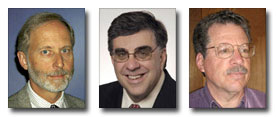LLNL scientists named SPIE fellows
 (Download Image)
John S. Taylor, Edward Moses and Alan M. Frank
(Download Image)
John S. Taylor, Edward Moses and Alan M. Frank
LIVERMORE, Calif — Three Lawrence Livermore National Laboratory scientists – Edward Moses, John S. Taylor and Alan M Frank – are among 72 new fellows elected this year by the International Society for Optical Engineering (SPIE). Fellows are members of distinction who have made significant scientific and technical contributions in the fields of optic, photonics and imaging.
Edward Moses, principal associate director of LLNL's National Ignition Facility (NIF) and Photon Science Directorate, was recognized "for specific achievement in high-energy lasers."
Moses is responsible for building and bringing NIF, the world's most complex laser system, into operation. When completed in 2009, experiments on NIF will access high-energy-density physics and fusion regimes with direct applications to national security and applications for fusion energy research, high-energy density science and astrophysics. Moses led the development of advanced diagnostics and laser technologies for national security, competiveness and energy needs.
John S. Taylor, LLNL group leader for Precision Systems and Manufacturing and a senior engineer in the NIF Target Fabrication, was recognized for "precision engineering and specific achievements in optical engineering for reflective extreme ultraviolet optics and assembled systems."
Taylor's career encompasses broad work within optics manufacturing and metrology, including optical instrumentation design, semiconductor manufacturing, and improved metrology and characterization methods for machining and polishing processes.
In addition, Alan M. Frank, retired from LLNL, was recognized for his specific achievements in high-speed photography and high-powered lasers.
SPIE is an international society dedicated to advancing an interdisciplinary approach to the science and application of light. For more information, go to the SPIE Website.
Contact
Linda Lucchetti[email protected]
925-422-5815
Related Links
International Society for Optical Engineering (SPIE)The National Ignition Facility
"Dawn of a New Era."
"In the Chips for the Coming Decade,"




